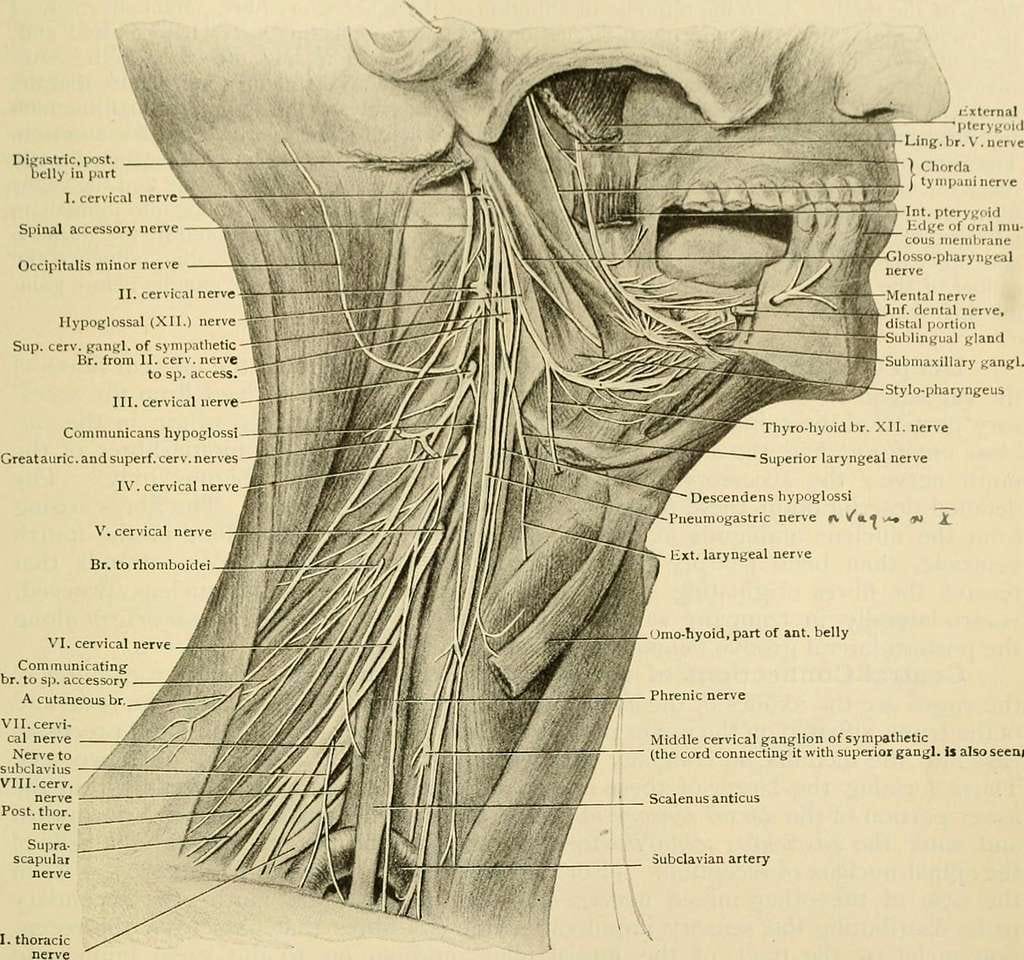What happens in the vagus
On the clinical limits of mind-body dualism

I.
Brightside Health collects too much data and pushes you through too many eerily cheerful videos but does meet patients where they are, customizing their treatment. (This, given how much they charge, is sort of the least they can do, and also a credit to their therapists much more than the company itself.) If you’re at a point where it’s less about the outlandish things your brain tries to make you think and more about making your limbic system and body respond to things more normally, with the correct amount of fight-or-flight or lethargy, they’ll work with you on that, instead of fine-tuning the way you talk to yourself ad nauseam.
Many people are in this place, having figured out how to swat away their mind’s most persistent distortions, and are now on a sort of treadmill, a 2-steps-forward-1-step-back deal, working on lower-level, longer-term things. Physical and hormonal issues, glitches of the autonomic nervous system, stuff fixed less by changing how you talk to yourself and more by how you act on yourself: exercise, sunlight, socializing, meditation. This physical element can be sticky and hard to get rid of; the body can be slow to catch up to what you rationally know. People with PTSD know this acutely. A Vietnam vet freaking out after a car engine has backfired is likely to know he isn’t back in Afghanistan, and suffers still. It’s like the problem is somewhere between — across? — the physical and mental. If he were to resign himself to the limits of the cerebral, pretending that his trembling fight-or-flight episodes were just a pesky byproduct of conscious thoughts, he wouldn’t get anywhere. He would effectively be giving up.
II.
I’ve been reading about the vagus nerve. Whether you’ve just heard a strange noise at night and gotten a shot of adrenaline or walked into a serene bookstore and immediately needed to take a shit, the vagus nerve was largely responsible. It’s the information superhighway between your brain and all parts south. It has “tone,” like a muscle, affecting how chronically nervous or calm you feel. It’s the grain of truth, the confounding variable, behind reflexology and chakras. It mediates the gut-brain connection. Many PTSD sufferers are keenly aware of the notion of “vagal tone” even if they don’t know that term specifically. Problems with it are central to the disorder and treatments targeting it are the only ones really showing promise. Substances like MDMA can get down to our “firmware,” artificially cranking up vagal tone, boosting one’s animalistic sense of safety, for hours. If you use those hours right, you can knock PTSD back on its heels for months or years. Other substances have done much the same for other conditions (not always via the vagus nerve but by similarly low-level mechanisms, below the tip of the conscious iceberg). LSD for alcoholism, ibogaine for opioid addiction.
Talk therapy alone tackles the matter more slowly and methodically. It untangles this great two-tiered knot, the mental outside the physical, from the outside. It trusts that if you erode and unravel enough of the silly thoughts that lay on top of the silly feelings, you’ll eventually undo the latter by default; the physical manifestations will run out of fuel and die. This is more or less correct. It’s just too slow. As much as cost, therapist shortages, and the background hum of problems larger than individuals that still hurt individuals, this slowness is part of its inaccessibility, and the mental health crisis at large.
III.
People look for quicker fixes for a messy combination of reasons. They aren’t trained medical professionals who can reliably tease apart symptoms that scream “see someone about this” and those that are just someone being an asshole, which can lead to more visible, outburst-y, hard-to-cure problems. People can be pressed for time because of things like this, but also because they’re busy, burdened, and accustomed to everything working fast nowadays. As such, the West, for the second time in 50 years, again from a place of self-imposed need and greedy fascination, is moving toward psychedelic therapy. John Oliver did justice to it as always, but he only covers something if it’s getting, or has gotten, fucked up.
The West has not suddenly realized with a little too much gusto that “the body matters too.” It’s carrying on in the same mindset as ever. “Mental illness is a failure of grindset, broseph, and psychedelics will take your grindset to a new level.” They are looking toward the ability of psychedelics to strengthen the mind’s ability to ignore the problems of body, or at best, to help mind and body as discrete parts — fix up whatever parts need fixing for that person to become a better producer of things. Its potential for healing the whole human, and wider networks of relationships beyond that, and other unprofitable things like enlightenment and la pura vida and buying less unnecessary shit — these are pesky sideshows to them. Psychedelics are being taken into the arms of capitalism not like an infant or a cherished elder but a bucket of seeds about to be tossed at aimless pigeons, a bulk commodity like any other, mere lubricant for the machinery of the brain.
IV.
Silver bullets are vanishingly rare, and doubly so when handed to us on a silver platter by the natural world. To treat plant medicines the way I’ve just described is to lock away 99% of the benefits of psychedelics and make them unwitting tools in propping up toxic socioeconomic orders and views of the brain and body. Treating mind and body as a couple of unruly tools, fully separated from each other as if occupying two different places a tool belt, may not be an explicit view held by many but remains the default one taken when plant medicines are ignored or used poorly. Then again, there may be something deliberate here: the connections between body and mind that plant medicines help us understand are politically dangerous. They remind one of other evidence of interconnectedness that capitalism is reluctant to let us remember; if problems across our guts and brains can be so tightly connected, what if the same can be said of problems across individual and collective lines?
What happens in the vagus does not stay in the vagus. Capitalism is now begrudgingly accepting this, and trying to make as much money off it as possible. Its approach is as lopsided and “mind-over-matter” as ever, and that’s the thing. Problems we ignore on one side of the vagus — brain or body — are liable to make themselves known on the other. No amount of psychedelics that are sold and administered just to patch people up quickly, in ways aimed at preventing them from dwelling on the anticapitalist bent of psychedelic insights or the collective nature of human well-being and suffering, makes this untrue. On the contrary, if you try to sterilize the experience, it will likely become a Trojan horse. Just as the MKUltra experiments created the Unabomber, Compass Pathways centers may wake many people up, in a particularly jarring environment, to the factory-line evils of unbridled capitalism, and the conflagration when it comes apart will only be all the hotter.




